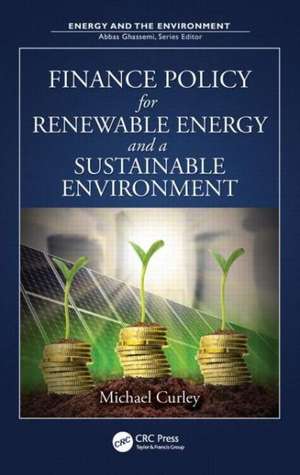Finance Policy for Renewable Energy and a Sustainable Environment: Energy and the Environment
Autor Michael Curleyen Limba Engleză Hardback – 18 mar 2014
Providing a historical overview of how we got to where we are now, and outlining the 23 principles needed to establish a stronger foundation for the future, this text presents the basic financial tools required to understand the concepts presented. It discusses the proper roles of grants, loans and guaranties, the concept and proper use of affordability, understanding leverage, and generating revenue streams for environmental programs. It also examines subsidies, financial risk reduction strategies, and the challenges posed by alternative energy as well as the next generation of environmental programs.
As it relates to how environmental projects and improvements are achieved, Finance Policy for Renewable Energy and a Sustainable Environment outlines the greatest benefits at the lowest possible cost to the public. This text is an ideal resource for upper-level undergraduate students in environmental engineering and business courses, as well as practicing environmental engineers.
Preț: 771.56 lei
Preț vechi: 1107.11 lei
-30% Nou
Puncte Express: 1157
Preț estimativ în valută:
147.66€ • 153.59$ • 121.90£
147.66€ • 153.59$ • 121.90£
Carte tipărită la comandă
Livrare economică 14-28 aprilie
Preluare comenzi: 021 569.72.76
Specificații
ISBN-13: 9781439894194
ISBN-10: 1439894191
Pagini: 258
Ilustrații: 30 b/w images
Dimensiuni: 156 x 234 x 25 mm
Greutate: 0.86 kg
Ediția:New.
Editura: CRC Press
Colecția CRC Press
Seria Energy and the Environment
ISBN-10: 1439894191
Pagini: 258
Ilustrații: 30 b/w images
Dimensiuni: 156 x 234 x 25 mm
Greutate: 0.86 kg
Ediția:New.
Editura: CRC Press
Colecția CRC Press
Seria Energy and the Environment
Public țintă
Academic and Professional Practice & DevelopmentCuprins
Paying for the Fix. The 23 Principles of Environmental Finance. The 2 Core Principles of Environmental Finance. Policy Principles of Environmental Finance. Management Principles of Environmental Finance. Revenue Raising Principles for Environmental Finance. Sources of Revenue for Environmental Finance Programs. Financial Principles of Environmental Finance. Financial Mechanics. Comparing Financing Alternatives. Hidden and Not-So-Hidden Cost Factors. Impact of Term on Annual Debt Service Payment. Grants and Affordability. The Role of Equity. The Curse of Subsidies. Leverage: The Power of Guaranties. Cost/Benefit Analyses. Credit Enhancement. Tariffs. Climate Change and Renewable Energy. Cap-and-Trade Programs. Driving Down Costs. Appendix: Countries with Non-Investment-Grade Ratings on Their Sovereign Debt.
Recenzii
"The book is written in a very clear way with many examples relating to everyday life experience that simplifies the explanation of financial products. The 23 principles offer a way to look at finance for environmental goods which is novel and innovative. It's important to note that only a small number are relevant solely to environmental finance - the vast majority relate to finance generally. Unfortunately governments do seem to have forgotten finance principles when they apply finance to the environmental sector (and quite often any sector!)."
––Dr Aled Jones, Director, Global Sustainability Institute, United Kingdom
"Mike Curley has provided us with a remarkably erudite, yet accessible, guide to financing the next great wave of environmental improvements. It is likely to become an indispensable source for generating new ideas to give us the biggest environmental bang for our buck."
––G. Tracy Mehan, III, Former Assistant Administrator for Water, US EPA
"Energy Policy cannot be made in a vacuum. Neither can environmental policy. Successful policies must consider cost and how those costs are financed. Mr. Curley’s book does just that: it shows us how to create the greatest benefits in terms of renewable energy and environmental improvements at the lowest possible cost to the people. For anyone interested in climate change and the environment, his book is a must-read."
––Bill Richardson - Former Governor of New Mexico
"This is a definitive work in the strongest sense: it presents environmental finance as a critically important, if mostly unrecognized, function within environmental management. More importantly, Curley draws on his long experience as an innovative and influential practitioner to describe, for the first time in one place, the operating principles that define the field. His analyses of these principles manage to uncover previously unsuspected truths in some areas while slaying sacred cows in others. And, remarkably, he does all of this with an easy style that is frequently entertaining but always clear and effective."
––John J. Boland, The Johns Hopkins University, Baltimore, Maryland
"Michael Curley is a thoughtful and committed environmental financier whose instincts are sound and observations insightful. He understands how precious our environment is and how few our dollars. His [book] is an essential contribution to 21st century environmental policy."
—G. Tracy Mehan, III in THE ENVIRONMENTAL FORUM, September-October 2014
––Dr Aled Jones, Director, Global Sustainability Institute, United Kingdom
"Mike Curley has provided us with a remarkably erudite, yet accessible, guide to financing the next great wave of environmental improvements. It is likely to become an indispensable source for generating new ideas to give us the biggest environmental bang for our buck."
––G. Tracy Mehan, III, Former Assistant Administrator for Water, US EPA
"Energy Policy cannot be made in a vacuum. Neither can environmental policy. Successful policies must consider cost and how those costs are financed. Mr. Curley’s book does just that: it shows us how to create the greatest benefits in terms of renewable energy and environmental improvements at the lowest possible cost to the people. For anyone interested in climate change and the environment, his book is a must-read."
––Bill Richardson - Former Governor of New Mexico
"This is a definitive work in the strongest sense: it presents environmental finance as a critically important, if mostly unrecognized, function within environmental management. More importantly, Curley draws on his long experience as an innovative and influential practitioner to describe, for the first time in one place, the operating principles that define the field. His analyses of these principles manage to uncover previously unsuspected truths in some areas while slaying sacred cows in others. And, remarkably, he does all of this with an easy style that is frequently entertaining but always clear and effective."
––John J. Boland, The Johns Hopkins University, Baltimore, Maryland
"Michael Curley is a thoughtful and committed environmental financier whose instincts are sound and observations insightful. He understands how precious our environment is and how few our dollars. His [book] is an essential contribution to 21st century environmental policy."
—G. Tracy Mehan, III in THE ENVIRONMENTAL FORUM, September-October 2014
Descriere
This book explains how environmental projects and improvements are achieved through the imposition of regulations, on the one hand, and financial incentives on the other. It discusses how those incentives can be organized to achieve the greatest environmental benefits at the lowest possible cost to the public. It presents the best environmental finance policies for the financing of alternative energy projects so that the ultimate cost of delivered power will decline. It also examines the challenges of the next generation of environmental programs.



















